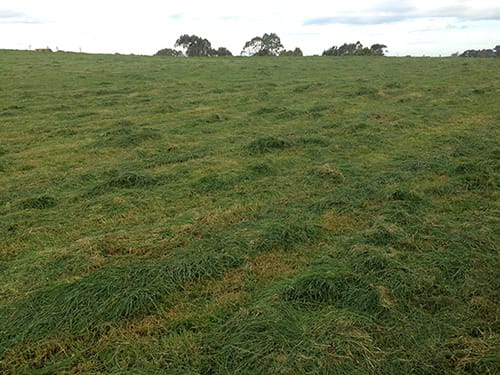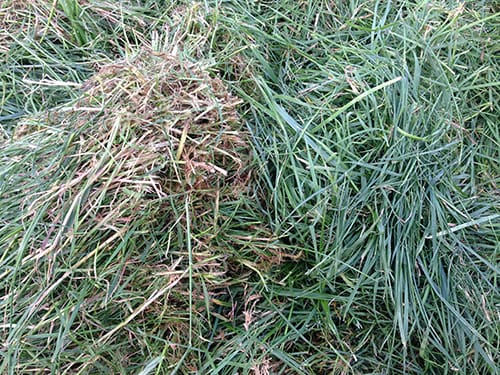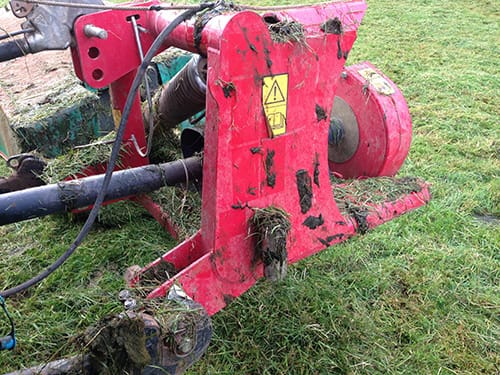What is pasture topping?
Let’s first start by defining pasture topping, which is a pasture management practice used to increase the quality and quantity of pasture growth at the time of year when the sward is turning reproductive. On-top of this, it is also used for ‘resetting’ the growing point of the plant where previous grazing rounds have failed to graze down to the desired post grazing residual. To do this, you use a mower attached to your tractor and mow (top) the paddocks pre or post grazing.
What time of year do you top pasture?
For the most part of the year, late summer, autumn, winter and early spring, the ryegrass pasture sward is largely in a vegetative state, which means that the plants are concentrating all their energy on growing leaves. In mid spring through to mid-summer (the topping season), the pasture turns reproductive and growth rates are high due to longer days, warmer temperatures, and plenty of soil moisture availability (depending where you farm).

A paddock topped pre-grazing
What are the benefits of topping pasture?
Cleaning up paddocks and by this, I mean mowing pasture to prevent full stem elongation of reproductive ryegrass and to influence the pasture’s growth rate. This is because it forces the pasture back towards a vegetative state where the plant allocates more photosynthetic material or energy into lush leaves and not seed heads for the time being.
Another major reason for topping is to clean up clumps and undesirable levels of pasture biomass from either rapid growth or not grazing down to the desired residual on previous grazing rotations. Kolver et al. (1999) suggests that both milk production and live weight gains can be attributed to topping pasture, due to the higher nutritional value of re-growth of topped pasture.
Should I top pre-grazing or post-grazing?
From trials conducted at Robin Hill, we’ve found that if you must top a paddock that the benefits of topping prior to the cows entering a paddock far outweigh topping after the paddock has been grazed. There are some articles that point to a negative effect on cow intake and milk production, but which also discuss mowing too low bringing soil into the ration and significantly increasing NDF with more stem. We’ve extensively tested the ins and outs of both practices and can confidently report on our experiences with the rest of this post and can say that pre-graze topping of grass when used within a normal grazing rotation will yield better results than post-graze topping.

A selection of topped grass pre-grazing
What are the benefits of post-graze topping?
There are few benefits of topping after the cows have left the paddock such as:
Smearing manure across the paddock, which will give a broader coverage of nutrients; however, if your soil biology and insects are healthy and doing their thing, then this isn’t the greatest reason to top post-grazing.
Perhaps you have a rocky farm and visibility of the ground is a must when mowing? Well, this is the best option for you, or better still, clean up your paddocks. We often coordinate the clean-up of rank paddocks with silage, but top the unfriendly silage making paddocks, this way we avoid hostile mower objects such as rocks.
One more benefit is that the cows will be given a choice to selectively graze where and what they like. This isn’t always ideal, as discussed further on, however, letting cows selectively graze may be advantageous if you have a paddock full of weeds or is highly dense in seed heads. You’ll want to limit the amount of undesirable plants that your cows consume and the best way to do that is to let your cows selectively graze. I’d also argue that if your paddock is that messy, then it should have been treated far earlier or perhaps topped in the previous grazing rotations.

A paddock topped post-grazing
What are the disadvantageous of post-graze topping?
All the above benefits are easily outweighed by the below disadvantages such as:
- The mower and tractor will generally be covered in a mixture of manure and grass cuttings, which means that everything needs to be washed down after use and everything will tend to rust quicker.
- You can drive quicker across the field when post topping and this may be a good and bad thing, good that you might be able to finish the job quicker, but bad if driving that little bit faster puts more stress on the machinery, thus shortening its life span and future durability.
What are the benefits and challenges of pre-graze topping?
A boost in animal performance i.e. a slight increase in milk production due to cows’ intakes increasing. Yep that is right, this goes against the train of thought that if you don’t allow cows to selectively graze the standing grass then they’ll eat more undesirable pasture, fill up quicker and take in less energy for milk; however, studies conducted in New Zealand and my own on-farm experiments have proven that it is best to top pre-grazing for the bump in milk production. This is also partly due to wilting of the pasture, thus removing a quantity of water, which tends to fill a cow up and leads me to the next point.
To achieve best results, you must be organised, which means knowing which paddocks you’ll be topping, having labour on hand and the tractor free, and topping within an appropriate timeframe of the cows grazing i.e. topping no further out then 6 to 12 hours. For example, at Robin Hill, we graze and milk twice a day and develop a grazing plan in Pasture.io for the week. This means we know where the cows are going and we can easily plan the topping in advance. This means that employees know when the tractor with a mower connected is needed and gives us the ability to start topping the night paddock right before the cows enter and in some cases, we’re finishing the paddock as the cows are entering. We then move onto the following day paddock, which means that we’ll be finishing the mowing around the 12-hour mark, but as the paddock will be cut and wilt overnight, we’re not too concerned.
Another important benefit, which flows into greater intakes is that if the force or the energy required by a cow to remove a mouthful of pasture is reduced then the cow can utilise the feed better. This means that larger mouthfuls of pasture are handled with more efficiency than smaller bites of standing pasture (Tharmaraj et al. 2003), which goes hand in hand for cows consuming (or vacuuming) readily available topped pasture.

Manure smear when topping post-grazing

Mower covered in manure from post-graze topping
What are your experiences?
We'd love to hear your feedback, or if you have some great tips that we can share in the post above - please feel free to get in touch or leave a comment below.
References:
Kolver, E, Penno, J, MacDonald, K, McGrath, J & Carter, W 1999, 'Mowing pasture to improve milk production', in PROCEEDINGS OF THE CONFERENCE-NEW ZEALAND GRASSLAND ASSOCIATION, pp. 139-146.
Tharmaraj, J, Wales, W, Chapman, D & Egan, A 2003, 'Defoliation pattern, foraging behaviour and diet selection by lactating dairy cows in response to sward height and herbage allowance of a ryegrass‐dominated pasture', Grass and Forage Science, vol. 58, no. 3, pp. 225-238.
